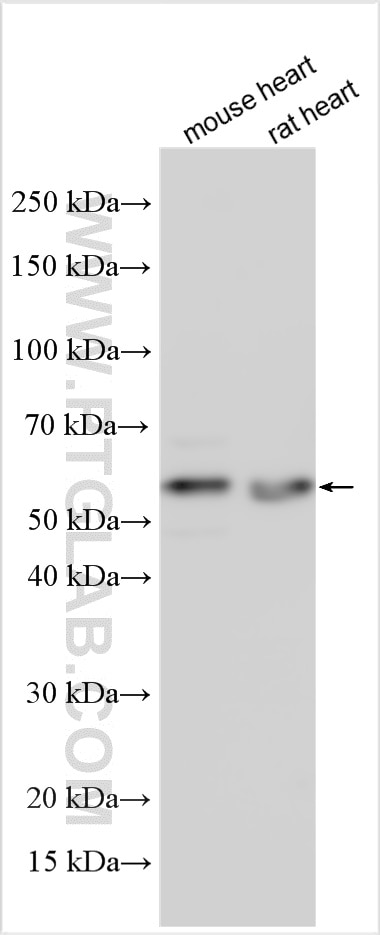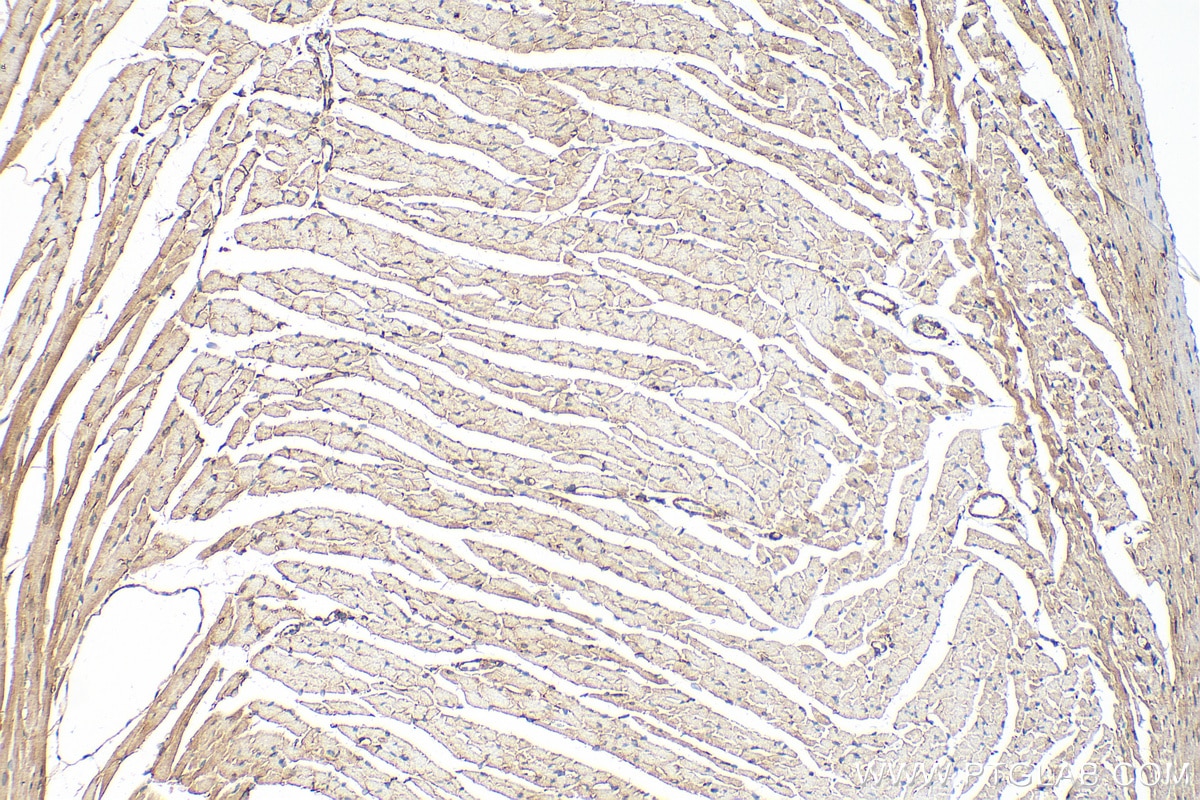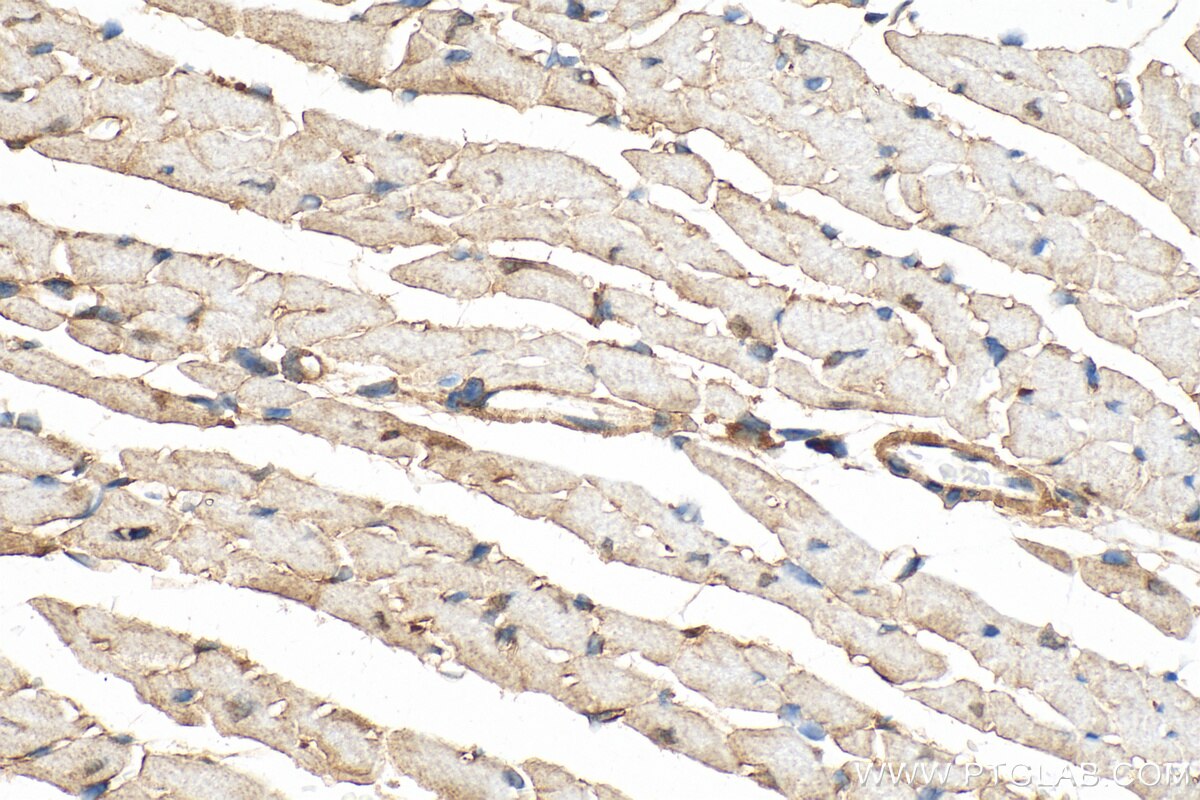Tested Applications
| Positive WB detected in | mouse heart tissue, rat heart tissue |
| Positive IHC detected in | mouse heart tissue Note: suggested antigen retrieval with TE buffer pH 9.0; (*) Alternatively, antigen retrieval may be performed with citrate buffer pH 6.0 |
Recommended dilution
| Application | Dilution |
|---|---|
| Western Blot (WB) | WB : 1:500-1:3000 |
| Immunohistochemistry (IHC) | IHC : 1:50-1:500 |
| It is recommended that this reagent should be titrated in each testing system to obtain optimal results. | |
| Sample-dependent, Check data in validation data gallery. | |
Published Applications
| WB | See 1 publications below |
Product Information
13131-1-AP targets SNTA1 in WB, IHC, ELISA applications and shows reactivity with human, mouse, rat samples.
| Tested Reactivity | human, mouse, rat |
| Cited Reactivity | mouse |
| Host / Isotype | Rabbit / IgG |
| Class | Polyclonal |
| Type | Antibody |
| Immunogen |
CatNo: Ag3820 Product name: Recombinant human SNTA1 protein Source: e coli.-derived, PGEX-4T Tag: GST Domain: 156-505 aa of BC026215 Sequence: KKTGKEVVLEVKYMKDVSPYFKNSTGGTSVGWDSPPASPLQRQPSSPGPTPRNFSEAKHMSLKMAYVSKRCTPNDPEPRYLEICSADGQDTLFLRAKDEASARSWATAIQAQVNTLTPRVKDELQALLAATSTAGSQDIKQIGWLTEQLPSGGTAPTLALLTEKELLLYLSLPETREALSRPARTAPLIATRLVHSGPSKGSVPYDAELSFALRTGTRHGVDTHLFSVESPQELAAWTRQLVDGCHRAAEGVQEVSTACTWNGRPCSLSVHIDKGFTLWAAEPGAARAVLLRQPFEKLQMSSDDGASLLFLDFGGAEGEIQLDLHSCPKTIVFIIHSFLSAKVTRLGLLA Predict reactive species |
| Full Name | syntrophin, alpha 1 (dystrophin-associated protein A1, 59kDa, acidic component) |
| Calculated Molecular Weight | 505 aa, 54 kDa |
| Observed Molecular Weight | 54 kDa |
| GenBank Accession Number | BC026215 |
| Gene Symbol | SNTA1 |
| Gene ID (NCBI) | 6640 |
| RRID | AB_3085408 |
| Conjugate | Unconjugated |
| Form | Liquid |
| Purification Method | Antigen affinity purification |
| UNIPROT ID | Q13424 |
| Storage Buffer | PBS with 0.02% sodium azide and 50% glycerol, pH 7.3. |
| Storage Conditions | Store at -20°C. Stable for one year after shipment. Aliquoting is unnecessary for -20oC storage. 20ul sizes contain 0.1% BSA. |
Background Information
SNTA1, also known as Syntrophin 1, SNT1, is cytoplasmic peripheral membrane scaffold proteins that are components of the dystrophin-associated protein complex. SNTA1 is a signal-transducing adaptor protein and serves as a scaffold for various signaling molecules. Alpha-1 syntrophin contains a PDZ domain, two Pleckstrin homology domains, and a 'syntrophin unique' domain. SNTA1 is the high expression in skeletal muscle and heart (PMID: 8576247, 8612778,). The PDZ domain of SNTA1 has been reported to bind to the C-terminal domain of murine cardiac voltage-gated sodium channels (SkM2) causing altering ion channel activity leading to Long QT syndrome(PMID 19684871, 19862833).
Protocols
| Product Specific Protocols | |
|---|---|
| IHC protocol for SNTA1 antibody 13131-1-AP | Download protocol |
| WB protocol for SNTA1 antibody 13131-1-AP | Download protocol |
| Standard Protocols | |
|---|---|
| Click here to view our Standard Protocols |








